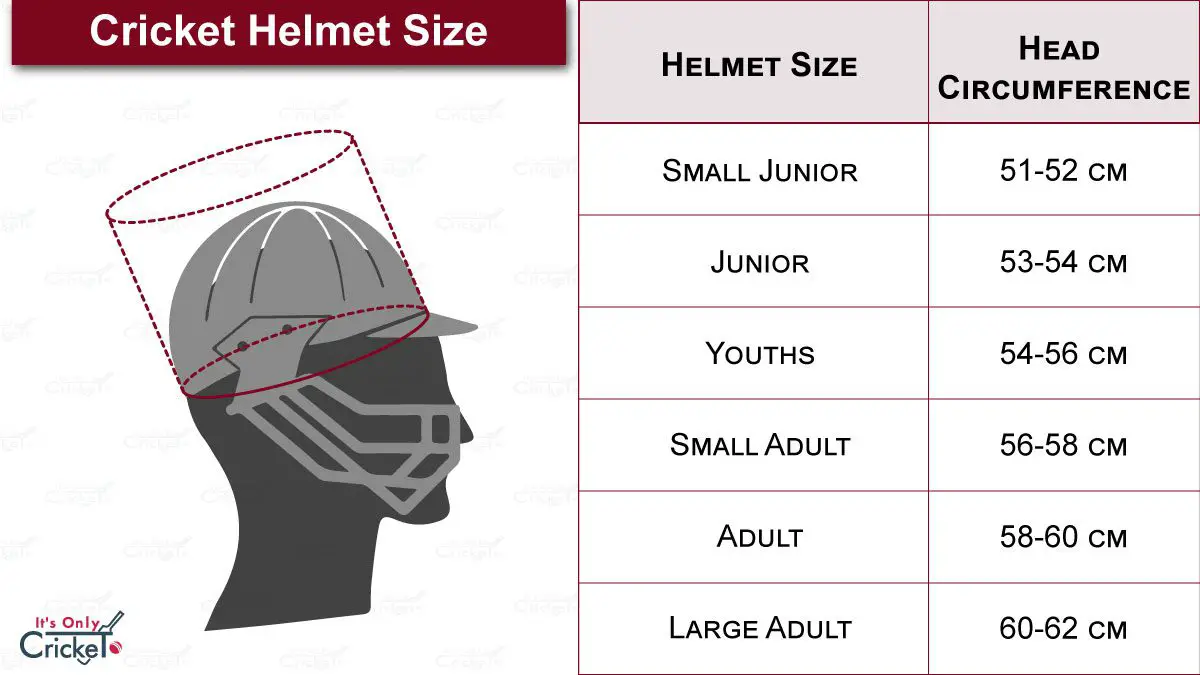Table of Contents
Any protective equipment in cricket is important, but none can save your life like a helmet can. Therefore, it is vitally important to make sure that it fits securely and comfortably. Hopefully, you will be wearing your helmet for a significant length of time in a game, so comfort is vital.
When buying a helmet there is only one measurement that is needed and that is the circumference (the outside) of your head. Once you know this measurement, you can look for and find cricket helmets that are available in your size and you are going to know whether you need a child or adult size.
Measure the Circumference of the Head
This is very straight forward to do with a flexible tape measure. Ask someone to hold the measure in place if possible or stand facing a mirror. The tape measure needs to start in the centre of your forehead and wrap around your head, back to the beginning point. The measure needs to be pulled tight but not so tight that it is painful. It is worth doing this more than once to get the most accurate measurement possible. If you don’t have a flexible measure, use a piece of string or wool, and then measure this instead. A slightly more unreliable method is to measure the inside of a cap that you wear on a regular basis. Only do this as a last resort or if you are in a rush to buy.

Check the Cricket Helmet Size Chart
Once you know your head circumference you need to check this against a cricket helmet size chart like the one shown below.
HELMET SIZE GUIDE | |
TO FIT | HEAD CIRCUMFERENCE |
SMALL JUNIOR | 51-52 cm |
JUNIOR | 53-54 cm |
YOUTHS | 54-56 cm |
SMALL ADULT | 56-58 cm |
ADULT | 58-60 cm |
LARGE ADULT | 60-62 cm |
This gives a good indication of the size you will need. A small adult for example will match a circumference between 56 and 58cm.
However, there are slight differences between brands including sizes and the names of each section. When buying a helmet, you must check each individual brand for slight differences as this can massively affect the comfort of the helmet. There is no standard measurement for small, medium and large across brands. Also, older models of the same helmet brand can be different so check, check and check again.
The following chart illustrates the differences in sizes based on head size measurements.
Masuri | Gray Nicolls | Kookaburra | Gunn & Moore | Shrey |
Junior Small 51-54 cm | Small Junior | Small/Mini | Junior Small | Small |
Junior Large | Small | Medium/Junior | Junior | Medium |
Senior Small | Medium | Large/Adult | Senior | Large |
Senior Medium | Large | Senior Large | Extra Large | |
Senior Large | Extra Large |
For example, a head size of 54cm could lead to a junior small Masuri, a small Gray Nicholls, a Mini Kookaburra, a junior Gunn and Moore and not being able to use a Shrey helmet.
Also, some sites list the measurements in cm and some list in inches. To convert cm to inches simply divide your cm measurement by 2.5. To convert inches into cm simply multiply by 2.5. This can lead to problems with measurement charts if your maths is slightly off. It is best to try and use a tape measure with both measurements on so that you don’t need to convert.
Use a Cricket Helmet that Fits the Head
All sportspeople have a preferred brand and are usually quite loyal to them. When buying a helmet, this cannot always be the case. Your chosen brand may not make helmets, or they may make a helmet which doesn’t fit your head shape. Although there is one standard measurement for helmets, they do not consider the uniqueness of head shape. Correctly fitting helmets will mould to your head shape through regular wearing and will become more and more comfortable. Do not ever buy a helmet which doesn’t fit or is uncomfortable to wear.

Be Really Careful if You Order Online
Online ordering is very convenient, but this can be a huge problem with cricket helmets. No-one wants the hassle of having to send back a helmet that doesn’t fit or isn’t comfortable. Obviously, you won’t know if the helmet fits until it arrives, so it is best to begin this process well before a season starts. Some people order multiple helmets to make sure they get the best one for them. Whilst this is effective in getting a helmet that is right for you, it is a huge hassle in sending back all the unsuitable ones. You also run the risk of delays in delivery or the helmet you need being out of stock which are both very frustrating. Strangely, people tend to order helmets that are too small rather than being too big. The advice from stockists is to err towards a larger size if you are unsure. For example, a medium Kookaburra sizes between 56 and 58cm and the large sizes between 58 and 62cm. The advice is to buy the large rather than the medium.
Conclusion
So, buying a helmet is important and it is worth spending the time to get it right. There are a lot of factors to consider when buying a helmet, especially when ordering online. Ideally, go into a store and try on different helmets where an expert will be on hand to guide you.
However, once you found the helmet that is most comfortable for you, make sure that you wear it correctly.


